|

By Jim Kessler
Illustration by Jim Frazier
Upon learning that at least three of the 9/11 hijackers entered the United States on student visas, Touran Waters’ first reaction was “Oh gosh, I hope I didn’t admit them.” Her second reaction, as GW’s senior associate director of admissions and director of international recruiting, was, “How are my students doing?”
The Sept. 11, 2001, terrorist operation, which succeeded in part because of the hijackers’ ability to exploit America’s visa system, ignited a debate in academia and in the halls of Congress over the risks and benefits of recruiting international students to study in the United States. On the one side are those who argue that the recruitment and education of international students benefits the United States economically, fosters international understanding, and broadens the horizons of American students. On the other side are those who see the student visa program as a gaping hole in the nation’s immigration net that allows virtually anyone to enter the United States so long as there is a willing educational institution in America eager to accept a tuition check.
Hanging in the balance is the future of international education and whether the system to provide visas to foreign students needs to be tweaked, overhauled, or radically cut back.
The Foreign Exchange
International education is big business.
Last year, nearly 600,000 students, or approximately one in 20 enrollees to graduate and undergraduate institutions in America studied in the United States thanks to some form of U.S. government-issued student visa. That is twice the number of foreign students studying in America as there was in 1980, which was twice that of 1970, and three times that of 1960. The money foreign students spend on tuition, room, board, books, and pizza alone adds about $13 billion to the U.S. economy—most of that accruing to colleges and universities.
To some, the burgeoning foreign student population is a natural and positive outgrowth of the globalization of America and the world. “America is stronger economically, richer culturally, more secure militarily, and healthier socially because of the steady increase in the number of immigrants, foreign students, educators, and researchers who have come here,” GW President Stephen Joel Trachtenberg said at a recent U.S. government summit on visa policy. “The world is more stable, more integrated, and more secure because of the millions of students who had the opportunity to learn here and experience America.”
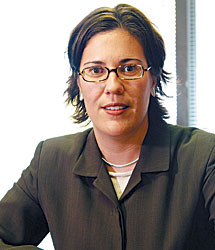
Touran Waters is GW’s associate director of admissions and director of international recruitment. With GW for 12 years, she has been leading international recruitment efforts for seven years.
Photo by Claire Duggan
|
On the other end of the spectrum are critics of the international student visa, who call the program carelessly run and poorly monitored. “The [student visa] program is so large, so corrupt, and so ineptly run that it’s actually worthwhile to stop, breathe for a minute and just ask a very simple question: Does the U.S. benefit at all from such a large-scale foreign student program?” asked Harvard’s Kennedy School public policy professor George Borjas, one of the lead critics of the international student visa program, at a June 2002 congressional hearing.
Like much of the rest of America pre-9/11, the student visa process was based on trust. Acceptance of foreign students was left solely in the hands of educational institutions, which were trusted to accept or reject international applicants on merit. Once a student was accepted by a school, institutions of higher learning trusted the government to approve or deny the prospective student’s visa application based on background checks, security concerns, and the U.S. consulate’s belief, or lack thereof, that the student intended to return home. And once a student was finally enrolled, the Immigration and Naturalization Service trusted the school to keep track of foreign students and to enforce the requirement that they attend school full time instead of disappearing in the fabric of America. Records of foreign students existed—but in the paper files of 73,000 education institutions cleared by the INS to accept international students.
Wanted: A Smaller Haystack
Three years later, centralized computers have replaced far flung paper files and the tracking of international students is monitored through the government’s Student and Exchange Visitor Information System database. The INS, well known for its long-time inefficiencies, has been dissolved—and its functions have been transferredto the Department of Homeland Security and its U.S Citizenship and Immigration Services, which oversees SEVIS.
Today, international students are tracked intensively through SEVIS—which keeps data on addresses, attendance in school, choice of major, off-campus employment, trips home, disciplinary action, and any change in status that would indicate the potential that a student might flee or commit harm to the United States. Nearly all of that information is supplied by educational institutions, meaning the success of SEVIS depends upon the efforts of college administrators.
Although SEVIS has been a controversial program, GW supports it and adheres to its requirements to the letter, as federal law requires.
“As a native New Yorker and a current Washingtonian, I will not pretend for an instant that the terror threat is not real. We are all willing to make sacrifices at our schools to make America more secure,” Trachtenberg said at the visa policy summit.
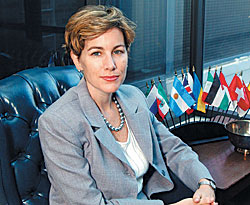
Tara Griffin Anne, director of GW’s International Services Office, has led her office through the post 9/11 challenges of complying with new federal laws mandating increased tracking and reporting of international students.
Photo by Claire Duggan
|
Since 9/11 the number of international students flagged by SEVIS, along with other measures to weed out terrorists, increased from 1,000 to 15,000 per year, according to NAFSA: Association of International Educators, a group that supports international education in the United States. Likewise, visa snags have become common, causing more than 1,000 students and even some professors to miss anywhere from a few days to an entire semester of school last year.
But some question whether these measures are really making America any safer. Student visas only represent about 2 percent of all visas granted in the United States. And students are far more likely to be denied or delayed entry because of simple mistakes, like the spelling of “Muhammed” on one document and “Mohammed” on another, rather than for any nefarious intentions.
Victor Johnson, public policy expert at NAFSA, says the new visa review process substitutes rote bureaucratic paper shuffling for judgment. “The way it works now, you review everyone because you’re afraid not to. Even if we gave an eminent scientist a visa every year for the past 20 years, we will put him through the whole review all over again in the 21st year,” Johnson says.
The true test of the system is to find the proverbial needle in a haystack. Or to put it into the fact pattern of 9/11, the various arms of the U.S. government are searching for three needles in a haystack of 600,000 strands of straw—the approximate number of international students admitted last year.
It’s a Beau Monde
The Tara Lara Academy of K-9 Hair Design in Mulino, Ore., is a two-year, for-profit pet grooming school. A call to its offices was answered by a man who spoke no English. The Air Excel school in Boulder City, Nev., is about 25 miles east of the Las Vegas strip and provides private and commercial pilot training ranging from $4,500 to $10,000. The Jerrytone Beauty School in Las Vegas appears to have no Web site, phone number, or street address. The staff of five at the Beau Monde College of Hair Design in Oregon offers classes in “hair design, nail technology, and facial technology.”
Each of these schools is among the thousands of for-profit vocational schools approved by the Citizenship and Immigration Service to accept foreign students. In fact, 73,000 educational entities are able to accept international students, according to the U.S. government. At the root of the problem, say critics, is that the student visa approval process is guided, and in fact, predicated upon first being admitted to a school, college, university, or vocational school. In other words, the first line of defense on our borders is the admissions officer at the Studio Seven Fashion Career College in Covina, Calif. Or it is the Airman Flight School in Norman, Okla., where Zacarias Moussaoui—often referred to as the 20th hijacker—reportedly trained to become a pilot and where 40 percent of its 500 students are international.
Long before 9/11, government officials expressed concerns about these institutions. “A school in the United States can be found for even the poorest academic achiever…. Unfortunately, schools that actively recruit foreign students for primarily economic reasons, and without regard to their qualifications or intentions, may encourage such high-risk underachievers to seek student visa status as a ticket into the United States,” warned Nancy Sambaiew, who was then the State Department’s deputy assistant secretary for visa services, at a May 1999 hearing before the House Judiciary Committee.
Touran Waters, who travels frequently for GW to attract international students, scoffs at the notion that her students are here to game the system. “It’s hard to imagine anyone coming to The George Washington University for any reason other than to acquire a quality education. Our standards are too high,” Waters says.
At GW and other four-year colleges and universities, the likelihood of a Zacarias Moussaoui or Mohammed Atta being admitted is remote. Foreign students have to clear academic and financial hurdles as high or higher than their American counterparts. At GW, successful foreign undergraduate applicants must have a solid B+ average in a challenging high school academic track. They must take the SAT in English and most score at least 650 on the math section. Students must pass a difficult English proficiency exam called the Test of English as a Foreign Language, or TOEFL. And perhaps the highest hurdle is that they must prove for their I-20 immigration form that they have the financial wherewithal to pay for full tuition, room, and board.
Yaser Mushtaq, a recipient of two master’s degrees at GW’s School of Business, agrees. “Getting accepted into a school is not easy. You need good scores and good credentials,” says Mushtaq, who is from Lahore, Pakistan.
Some people now question whether America should focus equally on each of the 600,000 students who obtain visas to study in the United States, or whether it should focus on those attending schools with low academic standards and easy financial requirements to attain.
“None of the hijackers used the type of visa that allows students to attend George Washington,” notes Susan D’Amico, associate director of GW’s International Services Office. The three 9/11 hijackers who entered the United States as students were admitted with an M-1 visa—a specific visa for vocational and technical schools.
Nearly all colleges and universities enroll students holding either an F-1 or J-1 visa, and GW undergraduates are primarily F-1 visa holders who are sponsored by their families. In general, J-1 visa holders are primarily K-12 students, graduate students, researchers, or professors who are sponsored and paid for by either their country or employer. For all student visa holders (including the M-1 visa), students must be accepted to and enrolled full time in an DHS-approved school and maintain a permanent overseas residence to which they are expected to return.
Only about one of every 100 student visas issued were of the M-1 variety favored by the 9/11 hijackers. The M-1 allows entry to those attending “an established vocational or other recognized nonacademic institution,” according to the Adviser’s Manual of Federal Regulations Affecting Foreign Students and Scholars, published by NAFSA. Focusing primary attention on international students attending schools that train pilots, blackjack dealers, cosmetologists, and dog groomers would cut the size of the haystack from 600,000 to around 6,000 applicants per year.
Reforming the M-1 visa might make the most security sense, but no one should underestimate the clout of for-profit vocational schools to lobby Congress to preserve the M-1. These same schools have for years successfully lobbied Congress to make them eligible for student loans and federal Pell Grants.
The Future for an International School
Tara Griffin Anne runs GW’s International Services Office and oversees a staff of 15. The ISO, as it is commonly called, serves Mushtaq, doctoral student Ana Lucia Hill of Mexico, and 1,900 other international students at the University—which is about 8 percent of GW’s students. On the graduate level, the number is even higher—nearly one in seven graduate students is a citizen of another country.
The operation of the ISO has changed since 9/11. Four years ago, one-fourth of the budget was devoted to activities to acclimate international students into GW life and help them cope with being in the United States and away from their families and spouses and to provide cross-cultural training and activities to the campus. Today, program activities account for only 3 percent of the budget with the rest going to solving visa problems and supplying up-to-the-moment data to SEVIS.
At the time of her interview with GW Magazine, it was August—which is crunch time for Anne and her staff. Of the approximately 450 new international students entering GW, Anne estimates that at least 15 of them were experiencing serious visa problems.
“Last year was more challenging because SEVIS was brand new. This year has gone more smoothly from the technical end, but there are still some students who are having trouble getting an appointment with the embassy because they did not apply early enough, some whose security checks have not been processed yet, and some who were denied F-1 or J-1 visa stamps in the first round,” Anne says. Orientation and classes were starting, and the clock was ticking.
In each of these cases, GW writes a support letter to the student and the embassy affirming the student’s acceptance, outlining the course of study and, in certain instances (such as for doctoral students coming to study engineering), assuring the authorities that the curriculum will not provide “dual use” education to foreigners—education that could help create weapons of mass destruction, for example. In such cases, the government may decide that a student is subject to a security check because of what he or she is coming to study. If the government believes the person is coming to learn chemistry for the “right reasons” after doing what’s called a Visa Mantis security check, then it will issue a visa (assuming there is nothing else that would make them believe the person is ineligible).
Though Anne understands that a stringent immigration process is appropriate for schools and important to America, she regrets that a handful of students may have to miss an entire semester due mainly to red tape.
“We have a student from Morocco who obtained his undergraduate degree at GW and is now earning a master’s in finance. He went home for a week and couldn’t return because his name is similar to someone on the terrorist watch list. He now must go to the U.S. embassy in Morocco to apply for a new F-1 visa. The problem is that there is no time limit and no rush to find out if he is or is not the person on the watch list,” Anne says. Clear timelines from the government for security checks and security checks that are valid for a student’s entire program rather than the current limit of one year would help ease the stress international students experience.
The Moroccan student will likely miss the semester. Still, with the help of the ISO, most students are able to cope with the changes brought about with SEVIS, the visa challenges, and the paperwork.
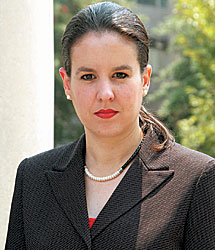
Ana Lucia Hill, of Mexico, received a master’s degree from GW and is now enrolled in a doctoral program in the School of Engineering and Applied Science, studying how to be able to respond to emergencies like 9/11.
Photo by Claire Duggan
|
Ana Lucia Hill is earning her doctorate at GW’s School of Engineering and Applied Science, studying the very type of crisis management that New York and Washington government officials faced on Sept. 11, 2001. She attended GW in a master’s program before 9/11 and has continued on for her PhD. In addition to a pair of master’s degrees from GW’s School Business, Yaser Mushtaq also earned a medical degree in Pakistan and is applying for a residency assignment at an American hospital.
“After 9/11, I was concerned about safety the way any resident of Washington would be concerned,” said Mushtaq, who attended GW from 1999 to 2003. As for the visa and entry process, Mushtaq says it has become much more detailed. “When I came in 1999, immigration did not ask me any questions. Now there is a lengthy interview and my bags are opened.” Mushtaq said he has never had any serious problems getting in and out of the country but has friends in Pakistan who experienced lengthy delays.
And as for the SEVIS system that now tracks her whereabouts, Hill is nonplussed. “Before 9/11, we thought that the INS knew everything about us. After 9/11, we know there is no way to control what people do. I never took it personally and never thought I wouldn’t be able to stay here.”
But what about the future Ana Lucia Hills and Yaser Mushtaqs?
Some of the more pointed opinions have come from people like Rep. Tom Tancredo (R.-Colo.), who say the security risks uncovered by 9/11 underscore the need to radically scale back the student visa program.
“It’s a challenge because you have institutions of higher education, which for—well, since the beginning of the discussion on this thing have been less than enthusiastic about their role in trying to monitor and control” students, Tancredo said at a congressional hearing he chaired on student visas and terrorism. “We should reduce [the number of student visas] so that we actually have an ability to operate a system effectively and efficiently, both with national immigration and specifically with this idea with the student visa program.”
But to President Trachtenberg and others, opponents of foreign students are taking a far too narrow view. Opponents, said Trachtenberg, “truly shortchange the economic benefit of having an Andy Grove, who was born in Budapest, come to America, study at City University of New York, and eventually start Intel—a multibillion dollar corporation that helped fuel the technology boom in America. As we are seeking to balance national security and economic security, how much is it worth to America that the world’s leading microchip manufacturer is located in California rather than Kyoto?”
“The George Washington University has always attracted international students. We are located in an international city. Students studying international business need to have international students in their class. Many prospective students say on their applications that they want to go to a school with people who are different,” added Waters.
There also is the foreign policy aspect. That foreign students can come and experience the United States, can learn about this country, and can then go home and share their knowledge, is invaluable to U.S. foreign relations.
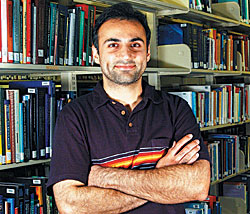
Yaser Mushtaq, of Pakistan, holds two master’s degrees from GW and is now studying to be a doctor.
Photo by Claire Duggan
|
Policymakers who would like to cut back the student visa program might get their wish, not through winning changes in the law, but through the free market. The fact is that universities are in a global competition for international students, a competition that America may now be losing. Australia, Canada, France, and the United Kingdom actively recruit foreign students with government support. Australia offers students up to six months of free English language classes. The UK allows foreign students to work at any job off campus—a perk that is not allowed in America. France has a major public relations campaign to recruit students. In the United States, there is no government support. Each school competes individually for students.
As for international graduate students—the cream of the crop—the outlook could be better. The number of international students who took the GREs—the standardized test used by most U.S. graduate programs to evaluate students—declined 30 percent in 2004. The increased likelihood of difficulty obtaining a visa is most often cited as the reason students are choosing to attend elsewhere, according to Anne. There is a perception that getting a visa is too hard, that the system is inflexible, and that America doesn’t want them.
But at GW, foreign student enrollment is expected to rebound to pre-9/11 levels. “We’ve found that international students often want to transfer to the U.S. because they are disappointed with their educational experience in other countries,” Waters says.
The student visa debate is sure to continue as lawmakers, university administrators, and policy analysts grapple with the conflicting notions of protecting our borders and admitting international students. The Bush administration seems genuinely interested in striking an appropriate balance with some cabinet-level agencies coming down along predictable lines—the Commerce Department in favor of more open borders, a position not favored by those who deal with national security interests.
For his part, Secretary of State Colin Powell, MBA ’71, has been a strong advocate for international education. In March while in Pakistan, he participated in a question-and-answer session with Pakistani students, one of whom expressed an interest in increasing foreign academic exchange between the United States and Pakistan. “Sir, all we have is bookish knowledge about America. We want first-hand experience about American society and culture,” the student said.
In an op-ed piece by Powell that was published in The Wall Street Journal in April, he wrote, “When a foreign student goes elsewhere to school, we lose not only the student, but his entire family, including siblings, who might have followed in his brother’s or sister’s footsteps. When scientists hold conferences in other countries, we lose their brainpower for institutions.”
New systems in place give the appearance, at least, that the government and educational institutions are more up to the challenge of screening applicants than was true pre-9/11. As Anne points out, “There are many non-immigrant visas that people can apply for in order to come to the United States. Frankly, the F-1 student visa is a tighter system than most because a school reviews the applicant’s academic record, ability to pursue a program in English, and ability to finance the program of study. That information is then sent to the government in order to issue a visa document. There is a significant amount of scrutiny before the individual goes to a U.S. Embassy to ask for a visa stamp.
But with the student visa program, the human element will always remain—something that Touran Waters realizes better than most.
“At some point with students you have take things at face value. They present a passport, transcript, plan for study, and financial records.” Waters says.
Perhaps the bottom line is that no system that treats The George Washington University and a dog grooming school the same is ever going to be perfect.
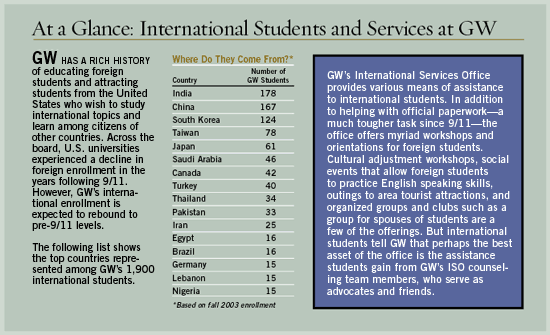
Jim Kessler is president of the D.C.-based consulting firm Definition Strategies and spent 12 years as a senior legislative aide in the U.S. House and Senate.
Back to top | Fall 2004 Table of Contents
|